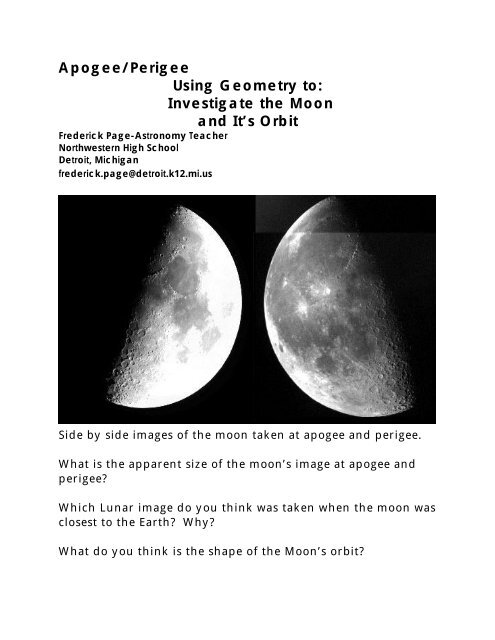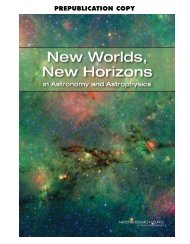Lunar Apogee/Perigee HOU Lesson - The Department of Astronomy ...
Lunar Apogee/Perigee HOU Lesson - The Department of Astronomy ...
Lunar Apogee/Perigee HOU Lesson - The Department of Astronomy ...
You also want an ePaper? Increase the reach of your titles
YUMPU automatically turns print PDFs into web optimized ePapers that Google loves.
<strong>Apogee</strong>/<strong>Perigee</strong><br />
Using Geometry to:<br />
Investigate the Moon<br />
and It’s Orbit<br />
Frederick Page-<strong>Astronomy</strong> Teacher<br />
Northwestern High School<br />
Detroit, Michigan<br />
frederick.page@detroit.k12.mi.us<br />
Side by side images <strong>of</strong> the moon taken at apogee and perigee.<br />
What is the apparent size <strong>of</strong> the moon’s image at apogee and<br />
perigee<br />
Which <strong>Lunar</strong> image do you think was taken when the moon was<br />
closest to the Earth Why<br />
What do you think is the shape <strong>of</strong> the Moon’s orbit
Let’s use the tools <strong>of</strong> Geometry to investigate this phenomena.<br />
Geometry: Fact One: If 2 intersecting chords are drawn in a<br />
circle, the product <strong>of</strong> the measures <strong>of</strong> the 2 parts <strong>of</strong> one chord<br />
will equal the product <strong>of</strong> the 2 parts <strong>of</strong> the other chord. (a<br />
chord is a line inside a circle that connects two different<br />
points <strong>of</strong> the circumference)(a secant is a line that passes<br />
through a circle and forms a chord inside the circle)<br />
Z=Diameter<br />
Z=Y 2 /X + X<br />
Y<br />
Fact Two: If you draw a perpendicular to a chord<br />
at the middle <strong>of</strong> the chord to the edge <strong>of</strong> the circle, the new<br />
line if extended across the circle pass directly through the<br />
middle <strong>of</strong> the circle and will constitute the diameter <strong>of</strong> the<br />
Secant Line<br />
X<br />
Perpendicular<br />
chord<br />
circle<br />
Diameter <strong>of</strong> Circle
1. Open <strong>HOU</strong>-IP s<strong>of</strong>tware.<br />
2. Obtain image disk from you teacher<br />
3. Open image moon-near-apogee030111.fts and image<br />
moon-nearperigee030124.fts<br />
4. Flip one <strong>of</strong> the images horizontally. (Manipulation,<br />
Add,Displayed Image. Select the other image. Save result in a<br />
new window. OK.)<br />
Window: <strong>The</strong> combined lunar image, center the image in the<br />
window using the side sliding bars then :<br />
1. Draw a vertical slice (chord) on the inner moon image<br />
that passes from the top edge <strong>of</strong> the image to the bottom edge.<br />
Draw as large a slice as you can fit inside the image, keeping the<br />
“x” coordinate with the same value as you slice from top to<br />
bottom- keeping the entire slice visible within the inner moon<br />
image.<br />
2. Using the slice graph window, hold the left mouse<br />
button and drag the curser across the slice to determine the<br />
exact length in pixels <strong>of</strong> your slice. Divide this value by 2 to<br />
determine the middle <strong>of</strong> the slice, then locate that exact spot<br />
using the same dragging technique you used to measure the<br />
length <strong>of</strong> the slice. As you drag the square to the center <strong>of</strong> the<br />
chord stop and it will remain there. Close the graph slice<br />
window.
3. Draw a second slice from the center point <strong>of</strong> your<br />
chord in step #2 that is a perpendicular to this chord out to<br />
the edge <strong>of</strong> the inner moon image. Measure the length <strong>of</strong> this<br />
line using your slice graph.<br />
4. Using the following equation based on the Geometry <strong>of</strong><br />
Circles, Z = Y 2 /X +X, determine the Value <strong>of</strong> the diameter <strong>of</strong> the<br />
inner Moon image.<br />
5. Repeat procedure steps 1/4 using the outer moon<br />
image in the combined lunar image window.<br />
Now, examine the two values you calculated for the<br />
diameters <strong>of</strong> the two images that were taken at different days<br />
<strong>of</strong> the month. What do you discover What can you conclude<br />
about the shape <strong>of</strong> the Moon’s orbit around the Earth Is it<br />
circular Explain.
Extra Thoughts:<br />
From your data in step 4. Can you calculate the apparent<br />
Moons % diameter size change.<br />
Can you calculate the expected % change in apparent image<br />
diameter size using the distances to the moon found in the<br />
Image info under data tools.<br />
How do the two calculated values compare What might<br />
explain any differences. (Hint: sources <strong>of</strong> experimental error)<br />
Michigan State Science Standards<br />
• Demonstrate an understanding <strong>of</strong> the motion <strong>of</strong> major<br />
objects in our solar system, including the rotation, orbit, and<br />
revolution <strong>of</strong> planets, moons, and asteroids.<br />
• All students will ask questions that help them learn<br />
about the world, design and conduct investigations using<br />
appropriate methodology and technology, and<br />
communicate finding using appropriate technology<br />
References<br />
http://hou.lbl.gov/~vhoette/Explorations/<strong>Apogee</strong>-<br />
<strong>Perigee</strong>/index.html<br />
(Vivian Hoette’s Activity)<br />
http://nssdc.gsfc.nasa.gov/planetary/factsheet/moonfact.html<br />
(NASA fact sheet on the Moon)<br />
http://www.astrosociety.org/education/resources/scifi.html<br />
(moon resource guide)<br />
http://www.nightskyobserver.com/<strong>Lunar</strong>Phase/ index.html<br />
(<strong>Lunar</strong> Phase Pro S<strong>of</strong>tware)<br />
Geometry, Prentice Hall c.1998, Laurie Bass,Basia Rinesmith<br />
Hall, Art Johnson, Dorothy Wood
Thanks To<br />
Vivian Hoette<br />
at <strong>HOU</strong>-University <strong>of</strong> Chicago Yerkes Observatory, whom<br />
without whose help and guidance this activity would not exist: my<br />
astronomer, teacher, and friend.<br />
Miroslav Bozinovich, Mark Karaim, and Susan Weed<br />
Northwestern High School Mathematics <strong>Department</strong>,<br />
who know their geometry<br />
My student’s<br />
at Northwestern High School, whom without I wouldn’t<br />
be challenged
NAME:_____________________________<br />
Date:________________<br />
<strong>Apogee</strong>/<strong>Perigee</strong> Data Sheet<br />
Z=Diameter<br />
Z=Y 2 /X + X<br />
Y<br />
Hypothesis on which image (left or right) was taken when the moon was<br />
closest to the Earth and <strong>Lunar</strong> orbital shape<br />
X<br />
Data: Step 2- Length in Pixels <strong>of</strong> inner moon chord slice_________________<br />
Step 2- Middle <strong>of</strong> inner moon chord slice ________________<br />
Step 3- Length in Pixels <strong>of</strong> inner moon perpendicular slice_________<br />
Step 4- Diameter <strong>of</strong> the inner moon image _______________
Repeated Procedure for Outer moon image:<br />
Step 2- Length in Pixels <strong>of</strong> outer moon chord slice_________________<br />
Step 2- Middle <strong>of</strong> outer moon chord slice ________________<br />
Step 3- Length in Pixels <strong>of</strong> outer moon perpendicular slice_________<br />
Step 4- Diameter <strong>of</strong> the outer moon image _______________<br />
What do you conclude about the shape <strong>of</strong> the orbit <strong>of</strong> the Moon around the<br />
Earth<br />
Looking for the distance to the Moon found in the Image Info under data<br />
tools, what was the % change in the distance for these two images<br />
How close to the %distance data was your % lunar image change
















